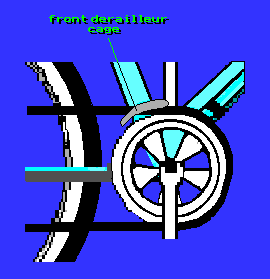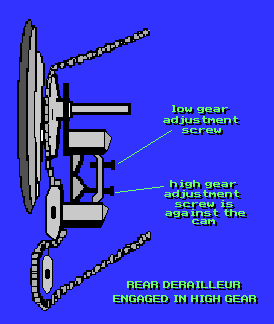"Save Big With Bicycle Discount Coupon Codes"
Replacing a Bicycle Derailleur Cable


Replacing a bicycle's cable is done the same way on almost all bicycle derailleurs and shifters.
1. Loosen the cable anchor bolt - the bolt that clamps the inner wire at the bicycle derailleur body.
2. Pull the cable inner wire out of the derailleur and cable casing. Then pull the inner wire out of the bicycle's shifter. Sometimes you may need to move the shifter back and forth to get a hold of the inner wire. As you are starting to pull the inner wire out, notice how it's end was positioned in the shifter.
3. Sometimes, the cable casing is difficult to replace. This is the case with Shimano STI shifters, bar-end shifters, and some other types, because the handlebar tape would need to be replaced. The casing can usually be reused unless the reason for the cable replacement is corroded (rust), or dirt has infiltrated the cable. If you are going to replace the casing, remove it at this time, but don't throw it away yet.
3a. If you are going to replace the casing, then lay the old piece(s) against the new casing, and cut the new casing to the same lengths as the old pieces. You can adjust the lengths as necessary. For instance, if the cable near the handlebar was too long and floppy, you would make the new one shorter. However, you've got to be careful not to make it so short that the handlebar can't be turned fully from side to side. Also consider how the cable will fit around reflectors, brake levers and such things. You may need to adjust the cable casing length to accommodate these items. When you cut the cable casing, use a sharp cutter. Electricians' pliers, also known as 'diagonals' or 'dikes' work best if you don't have an official cable cutter. The cable casing is a closely wound steel spring under a plastic coating. Work the cutter between the springy casing, and then chop. Sometimes, you'll get an unclean cut that will not fit into position, or will obscure the cable inner wire. If that happens, just chop again a couple of millimeters away. If you have never done this before, you might want to practice a bit on your old cable casing.
4. Most cable inner wires have two die-cast metal ends. Cut off the end that does not fit your shifter. Again, cutting cable requires a sharp and proper tool, and a bit of technique, so you might want to practice cutting up your old cable inner wire.
5. String the inner wire through the shifter.
6. Put some grease on the cable where it will be inside the cable casing. This will help avoid corrosion for many years. Push the inner wire through the cable casing. If you have cut the casing and the inner wire cleanly, it will push through very easily.
7. Position the cable in all the appropriate cable stops, adjusting barrels, and so on.
8. Make sure the shifter is in the slackest position. With rear derailleurs, this would be high gear position (smallest rear sprocket). With most front derailleurs, this is the low gear (smallest front sprocket) position, but some Suntour front derailleurs work the opposite way. Make sure the derailleur has the chain engaged on the smallest gear. All you've got to do is turn the pedals when no cable is connected, and the derailleur will naturally fall to the smallest gear.
9. If there are any adjusting barrels, either on the shifter or on the derailleur, turn them all the way in.
10. Pull the slack out of the inner wire, and tighten the anchor bolt. Anchor bolts are small and fragile, so be careful not to over-tighten it. If you have any old junk bicycles laying around, you might want to test the strength of anchor bolts. Go ahead and slowly tighten one on a junker until it breaks. That way, you'll know exactly how strong they are. However, keep in mind that some types are stronger than others.
11. Adjust the derailleur. Click here for front derailleur, or here for rear derailleur.
12. Cut off excess cable inner wire, leaving just a couple of inches beyond the anchor bolt so that you can grab it to tighten the cable in the future. Place a cable ferrule (hollow tip) on the end of the inner wire. Metal ones can be squished with pliers to keep them from falling off. Or, you can solder the end of the cable. Ferrules or solder keep the wire from unraveling at the end.
Special note for bar-end shifters and others that have casing under handlebar tape: Obviously, you'll want to replace the tape. Make a note of where the cable protruded from the tape and do it the same way when you replace the tape. You might use a bit of electrical or masking tape to hold the cable casing in place before putting the handlebar tape on. Put on the handlebar tape last, after the cable has been fully installed. Note that handlebar tape should stretched to avoid wrinkles, and help keep it in position. Most brands of handlebar tape give you barely enough length, so be careful to avoid overlapping too much. Always watch the outside of curves on the handlebar, because this is where gaps in your taping pattern will show up. Tape is usually applied from the center of the handlebar, toward the ends. Stand in front of the bicycle, wrap over the top, from the seat toward yourself. This way, as your grip naturally twists the tape, it will help to keep it tight, rather than working to unravel the tape. More on taping handlebars.
Tip: If you plan to replace both cables, and want to save money, you can usually salvage the rear derailleur cable for the front derailleur, so that you need to purchase only one new cable.
|
This
correspondence may be helpful: Having recently
purchased a new bicycle, I noticed that the gears weren’t working
properly. Since I was quite interested in learning more about my bicycle
and how it works, I stumbled across your site and started reading the
section about
tuning
up the deraileur. In my efforts to fix the problem, I managed to end up
stripping the end caps off the gear cable which has left me with quite a
badly frayed cable at the end. I did manage to get all the gears
engaging (24 - more than sensible, I'm beginning to think!), but not one
to give up or leave a job bogged, I've bought a new cable set which I
intend to fit. My main problem
seems to be setting the tension of the cable as it's fed through the
anchor bolt. I'm finding it very difficult to set it so that all gears
can be engaged when fine-tuning the high and low gear screws and the
adjusting barrel (It's a Shimano EZ Fire index shifter). Do you have any
tips for getting this right? I wonder if I should have soldered the end
of the cable while setting up the tension so it didn't fray so badly - I
think that this may have caused me the problem in the first place! Is
there any guide how tight to make the tension of the cable through the
anchor bolt? With the new cable I'd like to avoid re-tightening so many
times (which flattened my cable out of shape and led to it unraveling!) Thanks for your
help, John
Hi John,
Try this:
1. Screw in the adjusting barrel all the way. 2. Install the cable. 3. While the rear derailleur is engaged on the smallest sprocket, pull the slack out of the inner wire, and fasten the anchor bolt. 4. Shift into low a couple of times, then back into high (smallest sprocket) 5. Loosen the anchor bolt and pull the slack out since it will usually stretch a bit, the cable housing may compress, and everything will seat into its fittings. 6. Now make the final adjustment with the adjusting barrel. It will generally require a turn or so to bring the cable tension to the proper adjustment.
As to fraying: With practice, it pretty much doesn't happen at all.
You will want about 2 to three inches of cable inner wire left beyond
the anchor bolt as a 'tail' that you can pull when you want to
tighten it. This also leaves the cable in a servicable state so that
you can disassemble, clean, lube and reassemble it without needing to
replace the inner wire.
Good sharp diagonal cutters will reduce or eliminate fraying.
If the cable frays a bit after cutting, you can generally twist it
back together with your thumb and index finger - turning in the
direction the cable wire is wound.
I recommend soldering cable ends. It weighs less, is not
going to fall off, and looks nice and neat compared to crimp-on cable
ends. Soldering does not work for dirty cables or ones made from
stainless steel unless you use special stainless steel solder. Once
the cable is hot enough, the solder will flow between the strands via
capillary action, and make a nice neat aglet (cable end) with no
blob.
- Jeff |
3 Things You Need To KnowBefore You Buy
![]()
Tell a Friend About BicycleWebSite
Please feel free to link your web pages to www.bicyclewebsite.com.
![]()
Copyright © 1991-2014, bikewebsite.com